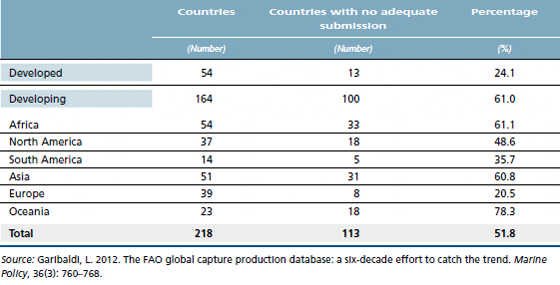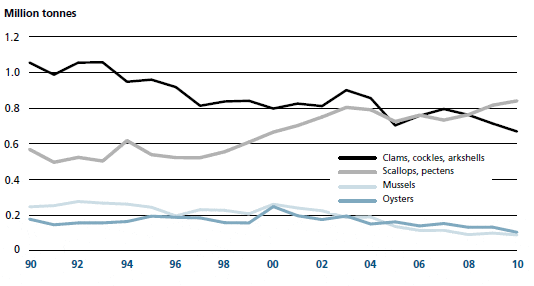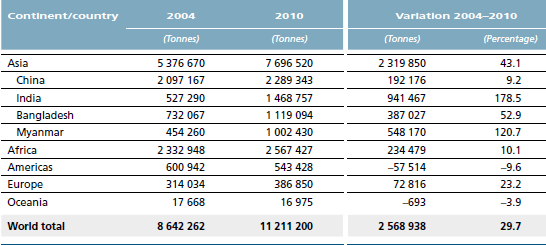To analyse trends, global production can be separated into three major
components: marine catches excluding anchoveta (Engraulis ringens); anchoveta
catches; and inland water catches (Figure 4). In the last seven years (20042010) for which detailed catch statistics are available, absolute variations in comparison with the
previous year of total marine catches excluding anchoveta never exceeded 1.2 percent,
ranging between 72.1 and 73.3 million tonnes. However, anchoveta catches decreased
from 10.7 million tonnes in 2004 to 4.2 million tonnes in 2010, and the variation on
the previous year exceeded 30 percent in two cases. In the same period, inland water
capture production grew continuously, with an overall increase of 2.6 million tonnes.
Recent Capture Fisheries Production by Three Major Components

A marked decrease in anchoveta catches by Peru in 2010 was mostly due to
management measures (e.g. fishing closures) that were applied in the final quarter to
protect the high number of juveniles present in the anchoveta stock as a consequence
of the La Nia event (cold water), which had favoured spawning and generated a good
recruitment. Thanks to this precautionary management decision, the 2011 anchoveta
catches exceeded their 2009 level. Other preliminary reports from important fishing
countries (e.g. the Russian Federation) show that 2011 should have been a year of
increased catches. However, Japanese fishery production will probably have dropped
significantly as the five prefectures hit by the earthquake and tsunami of 11 March
2011 accounted for about 21 percent of Japans total marine fisheries and aquaculture
production. Overall, preliminary information suggests that the total 2011 global catch
should exceed 90 million tonnes, marking a return to 200607 levels (Table 1).
Notwithstanding the protracted global economic downturn, which has reduced
the funds available to national administrations, the submission rates of 2009 and 2010
catch data to FAO have remained reasonably stable. However, it is well known that the
quality of fishery data is very uneven among countries. An evaluation3 of data quality
in capture statistics submitted to FAO found that more than half of the countries
reported inadequately. This percentage was greater for developing countries, but also
about one-fourth of reports by developed countries were not satisfactory. Countries
that should improve their data collection and reporting systems are mainly found in
Africa, Asia and among the island States in Oceania and the Caribbean (Table 2).
World Marine Capture Fisheries Production
With the great decrease in anchoveta catches, Peru is no longer second after China in the ranking of the major marine producer countries in terms of quantity as it has been surpassed by Indonesia and the United States of America. Some major Asian fishing countries (i.e. China, India, Indonesia, Myanmar and Viet Nam) reported significant increases in 2010, but also other countries (i.e. Norway, the Russian Federation and Spain) fishing in other areas and with more robust data collection systems showed growing catches after some years of sluggish production.
Countries or Territories with no Adequate 2009 Catch Data Submission

In particular, catches reported by the Russian Federation have grown by more
than one million tonnes since the low point of 2004. According to the authorities of
the Russian Federation, the recent increase is also a consequence of the management
decision to remove excessive formalities on documentation of landing operations, as
up until early 2010 landings by vessels of the Russian Federation in national ports were
treated as imports. Moreover, an official forecast of the Russian Federation indicates
further catch increases to a level of 6 million tonnes in 2020, representing an increase
of more than 40 percent above present levels.
Besides decreased production by Peru and Chile as a consequence of the drop
in anchoveta catches, other major fishing countries with downward trends in total
marine catches in 2009 and 2010 were: Japan, the Republic of Korea, and Thailand
in Asia; Argentina, Canada and Mexico in the Americas; Iceland in Europe; and to a
lesser extent New Zealand. Despite variable trends, Morocco, South Africa and Senegal
maintained their positions as the three major marine producers in Africa.
The Northwest Pacific is still by far the most productive fishing area. Catch peaks
in the Northwest Atlantic, Northeast Atlantic and Northeast Pacific temperate fishing
areas were reached many years ago (in 1968, 1976 and 1987, respectively) and total
production had declined continuously from the early and mid-2000s, but in 2010 this
trend was reversed in all three areas.
As for mainly tropical areas, total catches grew in the Western and Eastern Indian
Ocean and in the Western Central Pacific, and, in the last two, 2010 marked a new
maximum. In contrast, the 2010 production in the Western Central Atlantic decreased,
driven by the reduction in United States catches by about 100 000 tonnes, probably
mostly attributable to the oil spill in the Gulf of Mexico. Since 1978, the Eastern Central
Pacific has shown a series of fluctuations in capture production with a cycle of about
59 years. The latest peak was in 2009, and a declining phase may have started in 2010.
Both the MediterraneanBlack Sea and the Southwest Atlantic seem to be areas
where fisheries are in trouble as, since 2007, total catches have decreased by 15 and
30 percent, respectively. In the two areas along the southwest sides of America and
Africa, upwelling phenomena occur, although their intensity varies strongly each year.
In 2010, catches in the Southeast Pacific (excluding anchoveta) decreased whereas in
the Southeast Atlantic they grew, but examination of historical trends from an earlier
period reveals clear downward trajectories in both areas.
Finally, in the Eastern Central Atlantic, production has increased in the last three
years. However, in this area, total capture production is significantly influenced by
the activities of distant-water fleets and whether their catches are reported only by
the flag States or also complemented with information by some costal countries that
register foreign fleet catches in their EEZ but only make these data available to FAO
intermittently.
As noted above, annual catches by fishing area, country and in particular by species
very often fluctuate considerably, but all these variations combined seem to have a
counterbalancing effect on the global total. A demonstration of this is that catches of
more than 60 percent of the species varied by more than 10 percent in comparison with
2009 but the global total (excluding anchoveta) changed by only 1.2 percent.
It is well documented that fish populations show large fluctuations in abundance,
also in the absence of fishing. Although the causes are well known for some species
(e.g. anchoveta driven by changing environmental regimes), they remain unknown
for many others. Besides fishes, such variations also occur in other commercial groups
of species. For example, Argentina started industrial-level exploitation of Pleoticus
muelleri, a high-value shrimp, in the 1980s. However, this species showed a major
drop in 2005. Facing much reduced catches, the national authorities implemented
management plans to help the species to recover. After six years, catches had
rebounded tenfold reaching a new maximum recorded level in 2011 (Figure 5).
Catch Trend for Argentine Red Shrimp

Despite the decreased 2010 catches, anchoveta is again the most-caught species.
However, also in the presence of future favourable environmental regimes, yearly
catches of this species should not attain the past peaks as the Government of Peru
has introduced an annual quota for the whole country, subdivided by vessel, with the
purpose of stabilizing the capacity of both the fleet and processing plants.
In the list of top ten species, the most evident change is the disappearance from
the list of the Chilean jack mackerel (Trachurus murphyi), which had been sixth in 2008.
This species is a transboundary resource with a very wide distribution in the South
Pacific, ranging from the national EEZs to the high seas. After having peaked at about
5 million tonnes in the mid-1990s, catches were about 2 million tonnes in the mid-
2000s but have since declined abruptly, and the 2010 catches were 0.7 million tonnes,
the lowest level since 1976. Atlantic cod (Gadus morhua) has returned to the list, with
a total increase of almost 200 000 tonnes in the last two years to rank tenth in 2010, a
position not reached since 1998. In fact, in 2010, the whole group of gadiform species
(cods, hakes, haddocks, etc.) reversed the negative trend of the previous three years in which it had declined by 2 million tonnes. Preliminary data for this group also report
growing catches for 2011.
Catch Trends for Marine Bivalve Species Groups

Capture production of other important commercial species groups such as tunas and
shrimps remained stable in 2010. The highly variable catches of cephalopods resumed
growth after a decrease in 2009 of about 0.8 million tonnes. In the Antarctic areas,
interest in fishing for krill resumed and a catch increase of more than 70 percent was
registered in 2010.
Of the four marine bivalve groups (Figure 6), clams and cockles, which in the
early 1990s contributed more than half of the overall bivalve catches, have recently
accelerated their rate of decline. In 20092010, they were largely surpassed by scallops,
which in contrast have shown a rising trend since the late 1990s. Capture production of
mussels and oysters, for which reporting countries often have difficulty in separating
harvest of natural populations from aquaculture production, has not varied much over
the years, but an overall downward trend can be noted.
World Inland Capture Fisheries Production
Total global capture production in inland waters has increased dramatically since the
mid-2000s (Figure 3). Total production, as submitted by countries and as estimated
by FAO in cases of non-reporting, amounted to 11.2 million tonnes in 2010, an
increase of 30 percent since 2004. Despite this growth, there are still claims that
global production is much greater as some studies5 have pointed out that capture
production in inland waters is seriously underestimated in some regions. However,
the little well-documented evidence available concerns a limited number of countries.
On the other hand, inland waters are considered as being overfished6 in many parts
of the world, and human pressure and changes in the environmental conditions have
seriously degraded important bodies of freshwater (e.g. the Aral Sea, and Lake Chad).
Moreover, in several countries that are important in terms of inland waters fishing (e.g.
China), a good portion of inland catches comes from waterbodies that are artificially
restocked and closely monitored and, hence, it is probable that production is recorded
quite carefully. Therefore, both improvements in the statistical coverage and stock
enhancement activities may be contributing to the apparent increase in inland fishery
production.
A closer look at the statistics shows that the growth in the global inland water
catch is wholly attributable to Asian countries (Table 3). With the remarkable increases
reported for 2010 production by India (up 0.54 million tonnes on 2009) and by China
and Myanmar (up 0.1 million tonnes each), Asias share is approaching 70 percent
of global production. Considerable increases by some major Asian countries have
seriously influenced the global total in recent years but, in some cases, they seem to be consequences of a tendency to report continuously increasing catches or of changes in
the national data collection system.
Inland Capture Fisheries Production by Continent and Major Producer

For example, until 2009, the calculation of inland catches by Bangladesh was
linked to the population increase and, as a consequence, total production grew by
67 percent between 2004 and 2009. Production reported by Myanmar has quadrupled
in the last decade, increasing at an average growth rate of almost 18 percent per year,
gaining 11 positions in the global ranking of major producer countries, and exceeding
one million tonnes in 2010. The gathering of Indias catch statistics is complex as the
Ministry of Agriculture has to receive and assemble data from 28 states, which often
have different systems of collecting and reporting data. It is very difficult to discern
whether the dramatic growth (179 percent) in inland catches between 2004 and
2010 is ascribable to a real increase, to overestimation or to improvement in the data
collection system of some of these states.
Inland water capture production in the other continents shows different trends.
Uganda and the United Republic of Tanzania, fishing mostly in the African Great
Lakes, and Nigeria and Egypt, with river fisheries, remain the main producers in Africa.
Catches in several South American countries (e.g. Argentina, Colombia, Paraguay
and Venezuela [Bolivarian Republic of]) as well as in North American ones have been
reported as shrinking. Increased European production between 2004 and 2010 is all
attributable to a rise of almost 50 percent in catches of the Russian Federation. Inland
fishery production is marginal in countries in Oceania.
More than half of the global inland water capture production is still reported as
catches unidentified by species. However, in recent years, several countries have
made efforts to improve the quality of their inland catch statistics and collect data at
a finer species breakdown. In the last ten years, the increase in inland water species
with statistics in the FAO database has been five times that for marine species (Table 4).
Moreover, the percentage of inland water species in total species has improved,
reaching 12.3 percent in 2010 a value very close to the share (12.7 percent) of inland
water catches in global catches in that year.
August 2012
Further ReadingYou can view the full report by clicking here. |



